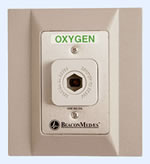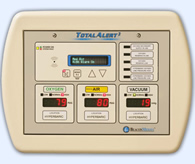Annual Medical Gas Pipeline Performance Verification (Retest)
Testing of medical gas and vacuum systems are typically classified as “certification” for the first time testing of new, upgraded, or renovated systems. Subsequent routine testing as part of a planned maintenance program is typically performed throughout the lifetime of the system as a means to verify patient safety and system performance, and is commonly referred to as “annual retesting”. Annual retesting of the existing medical gas system is a critical component of your planned maintenance program. It ensures that your equipment, from outlets to alarms, is in proper working condition. It is ultimately a goal of patient safety.
Outlets / Inlets

Testing of the medical gas outlets/ inlets is absolutely critical to make sure they are in proper working con-dition. We test each outlet /inlet with state of art test equipment that can deter-mine correct gas–correct outlet, static pressure, flows, dynamic pressure, or vacuum flows. We record each test in an easy to navigate report with all the information you are looking for. We also include the outlet/inlet manufacture and type as well as any other necessary comments. The test results are color coded for ease of finding “OK” or “BAD”. Our technicians are all certified NITC in maintenance and easily fix any broken or unfavorable outlets/inlets on the spot if requested. The repaired outlets are then tested again to ensure they are fixed and working properly.
Zone Valves

We will check all zone valves for leaks, gauge accuracy, labeling, and if pos-sible function. It is very important that all zone valves are in proper working condi-tion and are acces-sible, as they are the first line defense in a fire.
Alarms

We test all the area alarms the proper way. Anybody can push the “test” button on the front panel to check for LED and audible response, but we take it a step further. The NFPA states the alarms shall be checked for proper set points and function without affecting the pipeline. If the installed with demand checks,we will take the switches or transducers and put them on our test rig with an E cylinder of gas, and simulate the pressure changes to verify proper function and set points. This will give you the most accurate assessment of both your area and master alarms. We will also simulate the alarms if possible on your source equipment to very proper function.
Source Equipment
We will review all current source equipment, i.e. manifolds, air compressors…etc, for possible patient safety concerns. We do this by comparing your system to the current NFPA codes and requirements, and document any safety issues that may be present. An example of this could be a single line regulator on an O2 bulk farm. While often overlooked because it is “leased”, it could potentially be a life threatening situation if the regulator fails, there’s no back up, and you nobody was aware of the problem. It is our goal that you are notified of these “potential” concerns, as they may need to be addressed before there is a problem.
